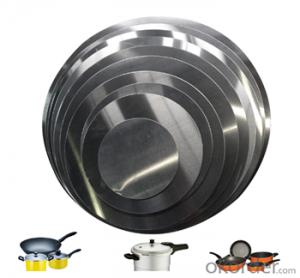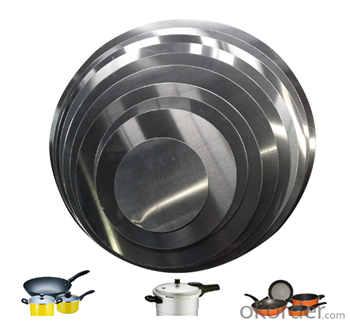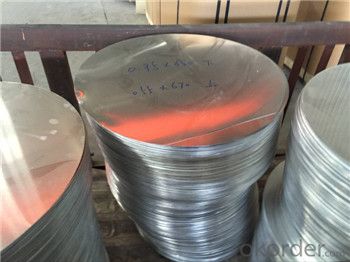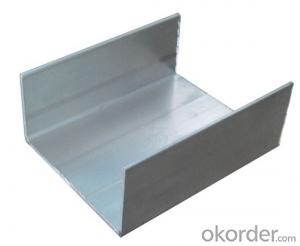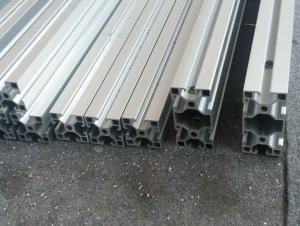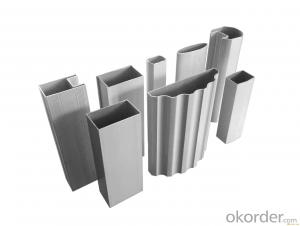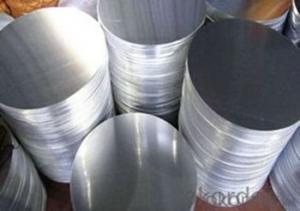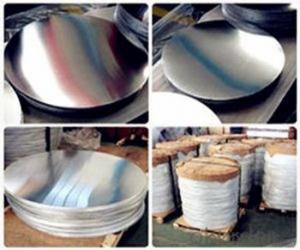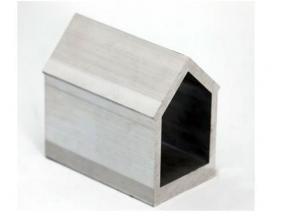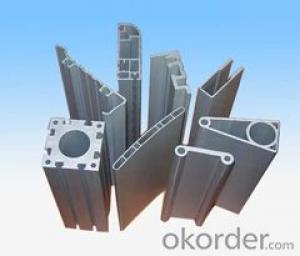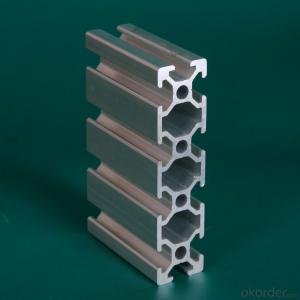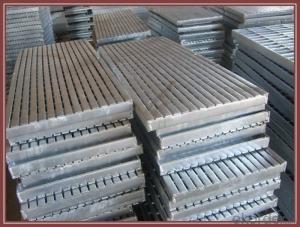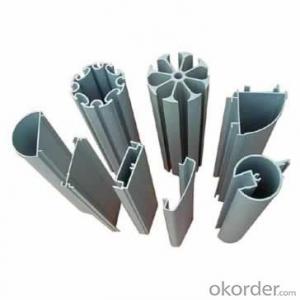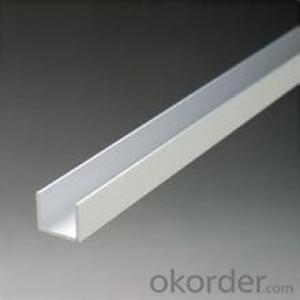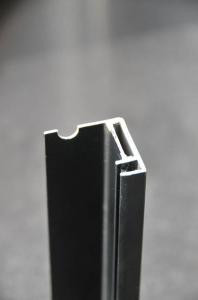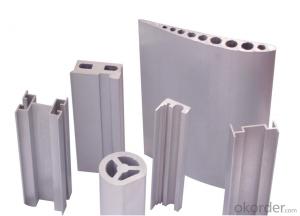Structural Aluminum Extrusion Profiles for High Quality Aluminum Disc Cookware at Great Prices
- Loading Port:
- Qingdao
- Payment Terms:
- TT OR LC
- Min Order Qty:
- 10000 kg
- Supply Capability:
- 100000 kg/month
OKorder Service Pledge
OKorder Financial Service
You Might Also Like
Specification
Aluminum Disc for Cookware

Aluminum Disc for Cookware Description
Aluminum disc is mainly used in making cookware, like non-stick pan, pressure cooker, hardware and pressure cooker and so on. Aluminum circle disc is the most widely used deep drawing products, High tensile strength, good ductility, Anodized quality and deep drawing quality which is suitable for cookware as well.
Aluminum Disc for Cookware Specifications
1.Alloy: 1100, 1050, 1060, 1070, 3003
2. Temper: O, H12, H14 aluminum round plate 1050
3. Thickness: 0.36mm ~ 5mm
4. Diameter: 120mm - 1000mm
Aluminum Disc for Cookware Picture
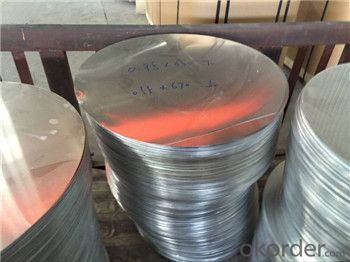
Aluminum Disc for Cookware Features
1. Excellent elongation and tensile strength;
2. Processing performance is good, stamping, stretch forming high performance;
3. Gas welding, hydrogen welding, resistance welding and brazing;
4. High plasticity, conductivity and thermal conductivity;
5. Easy to take all kinds of pressure processing and extension, bending.
Aluminum Disc for Cookware production process
In production,we must handle every link,every detail,and every work properly to ensure a high level of product quality.Therefore,Weihua creater s complete set of process,from aluminum smelting,to casting,cutting,heating and other linkes to track,control and guide the to do high-quality goods.
Introduction of our company
Our company is a professional Aluminium Strip manufacturer and Aluminum Circles manufacturers,mainly supply Aluminium Coil,Aluminum Circles,Aluminium discs,Aluminum Sheet,Aluminum Strip, Household Aluminum Foil,Aluminum Foil for Pharmaceutical Packaging,Aluminum Foil Tape,Aluminum Foil for Air Conditioner,Aluminum Foil for Container etc. series of aluminum products, sincerely welcome everyone to visit.
- Q: Are aluminum profiles suitable for use in exterior insulation systems?
- <p>Yes, aluminum profiles can be used for exterior insulation systems. They offer high strength, durability, and resistance to weathering, making them ideal for external applications. Aluminum profiles are lightweight, easy to install, and can be used to create a robust framework for insulating materials, enhancing the energy efficiency and thermal performance of buildings.</p>
- Q: Are aluminum profiles suitable for use in roofing systems in areas with high wind conditions?
- <p>Yes, aluminum profiles can be used for roofing systems in windy regions. Aluminum is a lightweight and durable material that can withstand high winds. It is often used in the construction of roofing systems because of its strength and resistance to corrosion. Additionally, aluminum profiles can be designed to meet specific wind load requirements, making them suitable for areas prone to strong winds. However, the design and installation of the roofing system must be done correctly to ensure it can handle the wind forces.</p>
- Q: Can aluminum profiles be used in modular construction?
- Indeed, modular construction can indeed utilize aluminum profiles. Possessing qualities such as being lightweight, sturdy, and long-lasting, aluminum profiles prove to be an optimal selection for modular construction endeavors. They can be effortlessly shaped and sized, thus allowing for flexibility in both design and construction. Moreover, aluminum profiles exhibit exceptional resistance against corrosion, a pivotal trait for modular structures that may face adverse weather conditions. Furthermore, the utilization of aluminum profiles in modular construction provides benefits such as reduced construction time, cost-effectiveness, and sustainability, given that aluminum is highly recyclable. In summary, aluminum profiles offer a dependable and efficient solution for modular construction projects.
- Q: Can aluminum profiles be used in structural applications?
- Yes, aluminum profiles can be used in structural applications. Aluminum is a lightweight and versatile material that offers excellent strength-to-weight ratio and corrosion resistance. It can be easily formed, welded, and machined, making it suitable for various structural projects such as building frames, bridges, and industrial structures.
- Q: Are aluminum profiles suitable for conveyor rollers?
- Conveyor rollers can benefit from the use of aluminum profiles. Aluminum, known for its lightweight and durability, offers several advantages for conveyor systems. Firstly, the strength-to-weight ratio of aluminum profiles is outstanding, making them an ideal choice for conveyor rollers. They possess enough strength to handle the weight of transported materials while being light enough to reduce the overall weight of the conveyor system. This results in energy savings and easier installation and maintenance. Additionally, aluminum profiles exhibit excellent resistance to corrosion, which is crucial for conveyor systems operating in harsh environments, such as those exposed to moisture or chemicals. This corrosion resistance ensures the longevity and reliability of the conveyor rollers, reducing the need for maintenance and associated costs. Furthermore, aluminum profiles can be easily customized and fabricated to meet specific requirements of the conveyor system. They can be extruded into various shapes and sizes, allowing for the creation of conveyor rollers that perfectly match the application's needs. This versatility makes aluminum profiles adaptable and suitable for a wide range of conveyor systems in industries like manufacturing, packaging, and logistics. Moreover, aluminum is highly sustainable as it can be 100% recycled, making it an environmentally friendly choice for conveyor rollers. By utilizing aluminum profiles, companies can contribute to their sustainability goals and decrease their carbon footprint. In conclusion, aluminum profiles are indeed a suitable option for conveyor rollers because of their lightweight, durable, corrosion-resistant, customizable, and sustainable characteristics.
- Q: What industries commonly use aluminum profiles?
- Aluminum profiles find wide applications in various industries, owing to their unique properties and versatility. The construction industry is one of the major sectors that extensively employs aluminum profiles. These profiles are utilized in the construction of windows, doors, curtain walls, and other architectural components. The lightweight nature of aluminum makes it an ideal preference for such applications, as it reduces the burden on the building structure. Similarly, the automotive industry heavily relies on aluminum profiles for manufacturing purposes. These profiles are used in the production of car frames, body panels, and components, offering an exceptional strength-to-weight ratio and corrosion resistance. By incorporating aluminum profiles, the overall weight of vehicles is reduced, resulting in improved fuel efficiency and performance. Aerospace manufacturing is another sector that heavily depends on aluminum profiles. These profiles are employed in constructing aircraft frames, wings, and fuselages. Their high strength and durability make them suitable for enduring the challenges of flight, while their lightweight characteristic contributes to fuel efficiency. The electronics industry also finds great utility in aluminum profiles. They are used in the production of heat sinks, aiding in the dissipation of heat from electronic components. Aluminum's excellent thermal conductivity ensures effective heat transfer, safeguarding sensitive electronic devices from damage. Furthermore, the furniture industry adopts aluminum profiles extensively in the production of lightweight and durable furniture pieces. These profiles are used to construct frames for chairs, tables, shelves, and various other furniture items. Their corrosion resistance and aesthetic appeal make them a preferred choice for both indoor and outdoor furniture. In conclusion, industries such as construction, automotive, aerospace, electronics, and furniture commonly embrace aluminum profiles due to their lightweight nature, strength, corrosion resistance, and versatility. These profiles play a vital role in enhancing the performance, efficiency, and durability of products in these industries.
- Q: Can aluminum profiles be used in aerospace applications?
- Aluminum profiles find extensive use in aerospace applications. The aerospace industry has relied on aluminum for many years owing to its advantageous properties. Crucially, aluminum profiles are lightweight, a vital characteristic for aerospace applications. This lightweight property aids in reducing the overall weight of aircraft, leading to improved fuel efficiency and increased payload capacity. Additionally, aluminum profiles possess a high strength-to-weight ratio, enabling them to withstand the stress and forces encountered during flight. The corrosion-resistant nature of aluminum is also advantageous in the harsh and corrosive aerospace environment. Moreover, aluminum profiles offer ease of machining and can be formed into intricate shapes, providing greater design flexibility. The combination of lightweight, strength, corrosion resistance, and ease of fabrication establishes aluminum profiles as an exceptional choice for a range of aerospace applications, including aircraft frames, wings, fuselages, and structural components.
- Q: This question asks about the impact of aluminum profiles on the sound insulation properties of a building.
- <p>Aluminum profiles can significantly affect the sound insulation of a building. They are often used in construction for their strength and lightweight properties. However, aluminum is a good conductor of sound, which can lead to sound transmission through the building structure. To enhance sound insulation, aluminum profiles are often combined with soundproofing materials such as acoustic foam or rubber seals. These materials help to absorb or block sound waves, reducing noise transmission. Additionally, the design and installation of aluminum profiles can also impact sound insulation; proper sealing and insulation techniques are crucial to minimize sound leakage.</p>
- Q: What are the different installation methods for aluminum profiles?
- Aluminum profiles can be installed using various methods, depending on the specific application and requirements. One common method is the use of screws to attach the profiles to the desired surface. This provides a secure and stable connection, making it suitable for various applications. Pre-drilled holes in the profiles facilitate this process. In some cases, aluminum profiles are welded together to create a strong and seamless joint. This method is commonly used in structural applications where high strength and rigidity are required. However, it requires specialized equipment and expertise. Another option is bolted installation, which involves using bolts and nuts to connect the profiles. This method offers flexibility as it allows for easy disassembly and reassembly if needed. It is commonly used in applications where frequent adjustments or modifications are required. Adhesive installation is another method that uses specialized adhesives or bonding agents to attach the profiles to the desired surface. This method is particularly useful when a seamless and aesthetically pleasing finish is desired, as it eliminates the need for visible screws or fasteners. It is commonly used in interior design, signage, and display systems. Clamping is a non-permanent method for installing aluminum profiles. Clamps or brackets are used to secure the profiles in place, allowing for easy adjustment or removal. This method is commonly used in applications such as exhibition booths, temporary structures, or modular systems. It is important to consider the specific requirements of the project and consult with professionals or manufacturers to determine the most suitable installation method for aluminum profiles. Factors such as load-bearing capacity, aesthetics, ease of installation, and maintenance should be taken into account to ensure a successful installation.
- Q: Is aluminum alloy made of industrial aluminum?
- Two, according to the alloy can be divided into 1024 categories: a 2011, 6063, 6061, 6082, 7075 grade aluminum alloy, which is the 6 most common. Grades are different in various metal components ratio is not the same, in addition to the usual windows In addition to aluminum such as the 60 series, 70 series, 80 series, 90 series, curtain wall series aluminum profile, aluminum industry has no clear distinction model, most manufacturers are in accordance with the actual drawings processing customer.
Send your message to us
Structural Aluminum Extrusion Profiles for High Quality Aluminum Disc Cookware at Great Prices
- Loading Port:
- Qingdao
- Payment Terms:
- TT OR LC
- Min Order Qty:
- 10000 kg
- Supply Capability:
- 100000 kg/month
OKorder Service Pledge
OKorder Financial Service
Similar products
Hot products
Hot Searches
Related keywords
